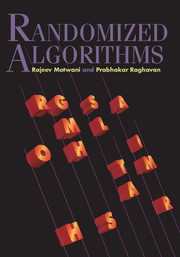Book contents
- Frontmatter
- Contents
- Preface
- I Tools and Techniques
- 1 Introduction
- 2 Game-Theoretic Techniques
- 3 Moments and Deviations
- 4 Tail Inequalities
- 5 The Probabilistic Method
- 6 Markov Chains and Random Walks
- 7 Algebraic Techniques
- II Applications
- Appendix A Notational Index
- Appendix B Mathematical Background
- Appendix C Basic Probability Theory
- References
- Index
5 - The Probabilistic Method
from I - Tools and Techniques
Published online by Cambridge University Press: 05 March 2013
- Frontmatter
- Contents
- Preface
- I Tools and Techniques
- 1 Introduction
- 2 Game-Theoretic Techniques
- 3 Moments and Deviations
- 4 Tail Inequalities
- 5 The Probabilistic Method
- 6 Markov Chains and Random Walks
- 7 Algebraic Techniques
- II Applications
- Appendix A Notational Index
- Appendix B Mathematical Background
- Appendix C Basic Probability Theory
- References
- Index
Summary
IN this chapter we will study some basic principles of the probabilistic method, a combinatorial tool with many applications in computer science. This method is a powerful tool for demonstrating the existence of combinatorial objects. We introduce the basic idea through several examples drawn from earlier chapters, and follow that by a detailed study of the maximum satisfiability (MAX-SAT) problem. We then introduce the notion of expanding graphs and apply the probabilistic method to demonstrate their existence. These graphs have powerful properties that prove useful in later chapters, and we illustrate these properties via an application to probability amplification.
In certain cases, the probabilistic method can actually be used to demonstrate the existence of algorithms, rather than merely combinatorial objects. We illustrate this by showing the existence of efficient non-uniform algorithms for the problem of oblivious routing. We then present a particular result, the Lovász Local Lemma, which underlies the successful application of the probabilistic method in a number of settings. We apply this lemma to the problem of finding a satisfying truth assignment in an instance of the SAT problem where each variable occurs in a bounded number of clauses. While the probabilistic method usually yields only randomized or non-uniform deterministic algorithms, there are cases where a technique called the method of conditional probabilities can be used to devise a uniform, deterministic algorithm; we conclude the chapter with an exposition of this method for derandomization.
Information
- Type
- Chapter
- Information
- Randomized Algorithms , pp. 101 - 126Publisher: Cambridge University PressPrint publication year: 1995
